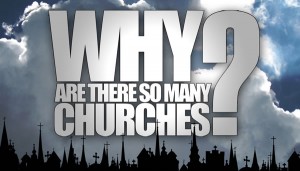
As we enter into the twelfth chapter of Revelation, a new series of visions are presented to the apostle John. Christ has already revealed the condition of his churches (Rev 1-3) as well as the fate of their enemies (4:1-8:5), and despite the depth of their tribulations he was coming to judge the persecutors of his people (8:6-11:19). But the message had still not sunk into their ears; the faith of the people still wavered and the Lamb’s warnings went unheeded. John therefore draws back the curtain even further to show the church what is going on backstage, and how these trying times fit into God’s grand strategy in the cosmic battle between good and evil.
As always, John indicates this change in function by a slight change in form. Rather than tie the section together by a single symbol (a letter, a seal, or a trumpet), he now presents a flowing narrative to further reveal the causes and consequences of the Lamb’s judgment. Here, in his fourth act (or episode) the apostle’s work parallels Greek drama even closer than before, giving us seven scenes of judgment (including two choruses), each marked by a verbal clue and a change in scenery. Notice the pattern:
- And a great sign appeared (Rev 12:1 ESV)
- And I saw (13:1)
- Then I saw (13:11)
- Then I looked (14:1)
- Then I saw (14:6)
- Then I looked (14:14)
- Then I saw another sign (15:1)
As the church soon realizes, God’s conflict with evil began long before Domitian came to power in Rome; it goes back to the beginning and perhaps even before the beginning. It is the story of a damsel in distress, a dragon, and a young prince. The serpent tempted and the woman sinned, but her punishment would also bring about the undoing of her curse (Gen 3). But the woman John sees represents not just Eve, but every woman since: whether suffering from a broken family like Leah and Tamar, fleeing a sinful past like Rahab, mourning the loss of a husband or a child like Ruth and Bathsheba, or enduring the shame of unwed motherhood like Mary, Eve’s daughters share in her pain. But they share in her glory, too, when they see their trials being woven into the plan of God’s glorious grace (Mat 1; 1Ti 2:15). From them a great nation arose (Rev 12:1-2; Gen 37:9-11) and from this people arose the Ruler of all nations (Rev 12:5; Gen 49:10; Psa 2:9). And so the bride of Christ can take strength in the thought that her sufferings, too, will not be forgotten, but will indeed lead to an even greater glory (Eph 5:22-27; Rom 8:18-30).
And though her enemy was old and powerful, God’s plan was too beautiful to be perceived by even one of the dragon’s terrible heads (Isa 27:1; 14:12-15). So he drives the woman to the wilderness to test her there, but God promises that her time will be short (Rev 12:6; 12, 14), and that he himself would be with her, protecting her, providing for her, and calling heaven and earth themselves to her aid (12:6-16; 1Co 10:1-11; Exo 16:13-15). But though Michael and his angels would fight the Devil, Satan’s defeat would come not through a feat of angelic arms, but by God himself coming as a child and being crucified as a criminal (Rev 12:5-11). And though Satan would send many saints to the grave, they would no longer have any fear of death, because Jesus had already been there, paving their way into a life the Devil had forfeited long before (Rev 1:18; 12:11-12; 17). The Lord’s people find shelter under the cross of Christ, because Satan stands before the Judge no longer as the Accuser, but as the Accused (Rev 12:10; Job 1:12, 2:6).
But while Satan has already begun his eternal sentence of suffering, his minions are still at work in the world around us (Rev 9:1-6). John therefore “stood on the sand of the sea” and watches as a beast emerges with seven heads (13:1; see ESV margin and NKJV). But it takes more than just one description of the beast to show how far he has fallen and how unjust his rule has become: he is a human king who has been crowned with the dragon’s own terrible power and authority (Dan 7:17, 23; 1Jo 5:19), he is a small and pompous horn (Dan 7:8, 11, 20), a “man of sin” and “son of perdition” (2Th 2), and the very enemy of Christ himself—the antichrist. John is the only one who uses this description in the New Testament, but intentionally avoids it in Revelation. The Rome of John’s day is one anti-Christian force among many, that denies the full divinity and humanity of Christ, and had even begun to persuade some in the church (1Jo 2:18, 22; 4:3; 2Jo 7).
Flushed with the heat of Hell’s fire, the beast wears “blasphemous names” and utters “haughty and blasphemous words” (Rev 13:1, 5). Domitian doubled-down on the blasphemies of his pagan forebears and called himself Deus (God), Tyrannus (Ruler), Despotes (Master), Ktistes (Creator) and Eirēnopoiōs (Peacemaker). And so what he viewed as a story of triumph would sound the death knell of the Flavian dynasty:
The beast falsely imitates the Lamb, “standing, as though it had been slain” [Rev 5:6]. . . . Rome, the manifestation of the beast in John’s day, seemed to have been mortally wounded by Nero’s suicide (A.D. 68) and the civil chaos that followed, but experienced a “resurrection” in the reigns of Vespasian and his sons Titus and Domitian [17:8]. Then in Domitian’s reign (A.D. 81-96), Nero’s beastly persecution of the church also revived. (The ESV Study Bible)
Regardless of any good he did on the throne, Domitian’s fate would be the same as that of Nero: an ignoble death and an infamous legacy. But he would not act alone. In fact, others would usually initiate the atrocities in his name, seeking his favor by compelling others to worship him. And there were many paths down which this twisted loyalty flowed: from the shameless deluding of the people in pagan temples (13:13, 15; 2Th 2:9-12), to the pressure in the marketplace (Rev 13:16-17), at times even resorting to force (13:15; 11:9-10). And like Domitian, these provincial leaders in Asia (the concilia in Latin, the koinon in Greek) would act like animals, so they are depicted as such: having “two horns like a lamb,” but speaking “like a dragon” (13:11) and deceiving even some of God’s own people to wear the name of the emperor rather than the name of Christ (13:14, 18; see NKJV margin).
But God had never tolerated such blasphemy: Sodom had fallen, Egypt had fallen, Babylon had fallen, Jerusalem had fallen, and now Rome too would fall (11:8; 14:8; Isa 21:9-10). In life they had become slaves to their passion (Greek thumos) and so in death they would become subject to his wrath (thumos; 14:8, 10). They would be crushed as grapes, and then forced to drain the cup of their own blood (14:17-19; Isa 63:1-6). By the time the messengers of God’s providence were finished, their suffering would stand as an eternal warning for all to see and repent (14:11, 20; Mat 13:41-42).
But for those who remain faithful during these times of persecution, the Judge of the earth promises a different verdict. The dragon may be the bane of the church, but the Lord is her balm, dwelling and walking among them (13:6; 1:12, 16, 20). They wear an eternal name that cannot be removed by any man or angel (14:1; 7:1-4; 9:4). And even if death separates them from their loved ones, they will be gathered into the barn of the bounty of the Lord (14:13-16; Mat 13:30), where they will sing “a new song,” “of Moses . . . and. . . the Lamb,” which not even angels can sing (14:3; 15:3-4).
These saints, wearied from their earthly sojourn, therefore walk on water toward their Savior under a sky radiating his own beauty, as heaven and earth prepare to unleash the judgment of the Lamb (4:1-6; 15:5-8; Exo 40:34-35; 1Ki 8:10-11). These are those, “who have not defiled themselves . . . who follow the Lamb wherever he goes . . . redeemed from mankind . . . and in their mouth no lie was found, for they are blameless” (Rev 14:4-5). In other words, those who lived like Jesus: “For to this you have been called, because Christ also suffered for you, leaving you an example, so that you might follow in his steps. He committed no sin, neither was deceit found in his mouth. When he was reviled, he did not revile in return; when he suffered, he did not threaten, but continued entrusting himself to him who judges justly” (1Pe 2:21-23).
And as John himself writes, “Here is a call for the endurance and faith of the saints” (Rev 13:10).
The following files are now available for free viewing and download:
Attachments
- 04 Slides: The Seven Trumpets (Rev 8:6-11:19)
Audio Recordings
- Week 24: The Seven Signs, Part One (12:1-5)
- Week 25: The Seven Signs, Part Two (12:6-17)
- Week 26: The Seven Signs, Part Three (13:1-4) **Session was not recorded**
- Week 27: The Seven Signs, Part Four (13:5-15)
- Week 28: The Seven Signs, Part Five (13:16-14:5) **Session was not recorded**
- Week 29: The Seven Signs, Part Six (14:6-15:8)
- Week 30: The Seven Signs and Bowls (15:1-16:9)
Works Cited
- The ESV Study Bible. Ed. Lane T. Dennis & Wayne Grudem. Crossway, 2008. Accordance.
Cross-posted from In His Image.




